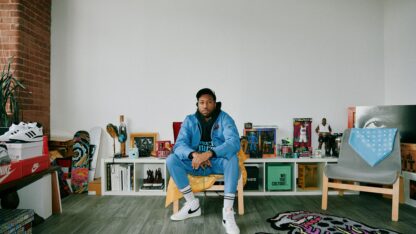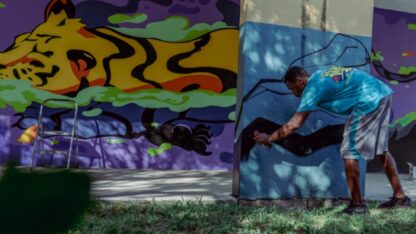Charmaine Minniefield explores her ancestral roots in exhibit 'Indigo Prayers'

The “ring shout” is an African-American practice of resistance, and the origins go back to West Africa, predating enslavement. Artist and activist Charmaine Minniefield explores this and her ancestral roots in a new exhibition at the Carlos Museum of Emory University, “Indigo Prayers: A Creation Story.” She joined “City Lights” host Lois Reitzes via Zoom to talk about her recent research and how it informs her new body of work.
Interview highlights:
How an unexpected detainment led to personal and artistic discoveries:
“I was in the Gambia right before COVID, and the pandemic broke out, exploring an opportunity to set up a home for my family so that we might continue our research in West Africa of our origins,” said Minniefield.
“While there, forced unexpectedly to remain during COVID, I had a chance to search for evidence of my family just by pursuing those expressions that were evidence of our cultural identity. So dance, music, movement, medium. Actually, the materials that I used, I painted in indigo as an ode to my ancestors, who brought indigo here with them during enslavement. And the trade skills that came as well; I painted in crushed oyster shells, indicative of architectural accents… in both the Southeast and the Gullah Geechee corridor, and on the coast of West Africa.”
Roots of the ring shout:
“The ring shout was a gathering and worship practice that was performed by enslaved Africans in the Southeast in particular; of course, it migrated,” explained Minniefield. “But what it was, was we would gather in a circle, and we would sing and call-and-response. We would move counterclockwise, the whole room of us, lifting up our collective intentions in prayer. And we did this in resistance to laws that were meant to dismantle community and to dismantle identity.”
She continued, “We preserved our identity in these sometimes-secret spaces called praise houses. A praise house was where the floor was our communal drum because drums had been taken. Drums were a form of communication, so it was not allowed. So we created drums out of these floors, and they are sacred in these communities as spaces to preserve.”
Expressing resistance with sacred materials:
“While I was in the Gambia, it was a challenge to find materials… Just creating the work included collecting materials in medium, and that allowed for me also to interact with keepers of those traditions for generations. So crushed oyster shells actually lives inside of the trade skills of construction, and the indigo, of course, is a sacred dye that’s used in clothing and fabrics. And the techniques I was able to witness and cherished included symbols and messages…. I also was able to use mahogany bark, crushed mahogany bark, as the brown or the red in my skin.”
“The images that are at the Carlos Museum are all self-portraits,” said Minniefield. “That body of work was triggered by the loss of loved ones. We were all experiencing the uprisings in resistance to the murders of George Floyd and others…. I wanted to resist all that was happening in the world, especially here in the US and the streets and against Black and brown bodies. I wanted to resist the way that my ancestors did and call on that memory all the way from my beginnings to my present, and that included medium, and materials, and memories as I did so, and the result is eight-foot size self-portraits, seven images.” Charmaine Minniefield’s new solo exhibition, “Indigo Prayers: A Creation Story,” is on view at the Michael C. Carlos Museum through Sept. 11. More information can be found here.








